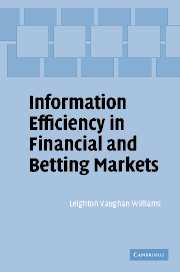Book contents
- Frontmatter
- Contents
- List of figures
- List of tables
- List of contributors
- Introduction
- Part I The concept of information efficiency
- Part II Selected readings
- 4 An assessment of quasi-arbitrage opportunities in two fixed-odds horse-race betting markets
- 5 The presence of favourites and biases in bookmakers' odds
- 6 Searching for semi-strong form inefficiency in the UK racetrack betting market
- 7 Models, markets, polls and pundits: a case study of information efficiency
- 8 Longshot bias: insights from the betting market on men's professional tennis
- 9 Biases and insider trading in exotic bets on thoroughbreds
- 10 On the improbability of information efficient parimutuel betting markets in the presence of heterogeneous beliefs
- 11 Modelling gambling demand in a laboratory casino: discovering the importance of individual-specific effects
- 12 Market efficiency of the 50–30–20–10 horse-racing spread betting market
- 13 Insider trading and bias in a market for state-contingent claims
- 14 Rationality and efficiency in lotto games
- 15 Efficiency of the odds on English professional football matches
- 16 Modelling distance preference in flat racing via average velocity
- 17 Testing for market efficiency in gambling markets: some observations and new statistical tests based on a bootstrap method
- 18 Information (in)efficiency in prediction markets
- Index
- References
14 - Rationality and efficiency in lotto games
Published online by Cambridge University Press: 09 July 2009
- Frontmatter
- Contents
- List of figures
- List of tables
- List of contributors
- Introduction
- Part I The concept of information efficiency
- Part II Selected readings
- 4 An assessment of quasi-arbitrage opportunities in two fixed-odds horse-race betting markets
- 5 The presence of favourites and biases in bookmakers' odds
- 6 Searching for semi-strong form inefficiency in the UK racetrack betting market
- 7 Models, markets, polls and pundits: a case study of information efficiency
- 8 Longshot bias: insights from the betting market on men's professional tennis
- 9 Biases and insider trading in exotic bets on thoroughbreds
- 10 On the improbability of information efficient parimutuel betting markets in the presence of heterogeneous beliefs
- 11 Modelling gambling demand in a laboratory casino: discovering the importance of individual-specific effects
- 12 Market efficiency of the 50–30–20–10 horse-racing spread betting market
- 13 Insider trading and bias in a market for state-contingent claims
- 14 Rationality and efficiency in lotto games
- 15 Efficiency of the odds on English professional football matches
- 16 Modelling distance preference in flat racing via average velocity
- 17 Testing for market efficiency in gambling markets: some observations and new statistical tests based on a bootstrap method
- 18 Information (in)efficiency in prediction markets
- Index
- References
Summary
Introduction to the ‘lotto’ game
‘Lotto’ is among the most popular games offered by state lottery associations accounting for roughly one-quarter of total revenues for state-run US lotteries in the late 1990s and early 2000s. As of August 2004, forty states had state-run lotteries, and every state with a lottery offered some version of a lotto game either through their own game or through a multi-state association such as the twenty-seven-state Multi-State Lottery Association (Powerball) or the eleven-state Big Game/Mega-Millions association.
Lotto games generally consist of an individual picking a set of five or six numbers from a group of approximately 35–55 choices. Winning numbers are then randomly selected at a weekly or bi-weekly drawing. A player whose ticket matches all of the winning numbers wins the jackpot prize, which is funded by allocating a percentage of ticket sales to the jackpot prize pool. Players matching some but not all of the winning numbers win smaller consolation prizes. If more than one ticket matches all the numbers, the money in the fund is divided evenly among the number of winning tickets while if no ticket matches the winning numbers, the money in the fund is carried over into the next drawing and is added on to the allocated funds from ticket sales in the next period. Because the jackpot prize fund is allowed to roll-over in this manner, the jackpot prize can become quite large if no one hits the jackpot in a large number of successive periods.
- Type
- Chapter
- Information
- Information Efficiency in Financial and Betting Markets , pp. 313 - 329Publisher: Cambridge University PressPrint publication year: 2005
References
- 6
- Cited by



